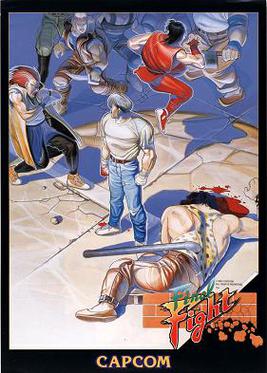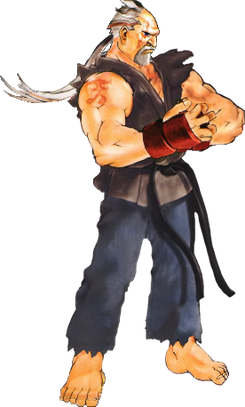See also
- Final Fight Championship, European fight promoter
The Final Fight or variant may refer to:

A player character is a fictional character in a video game or tabletop role-playing game whose actions are controlled by a player rather than the rules of the game. The characters that are not controlled by a player are called non-player characters (NPCs). The actions of non-player characters are typically handled by the game itself in video games, or according to rules followed by a gamemaster refereeing tabletop role-playing games. The player character functions as a fictional, alternate body for the player controlling the character.

Street Fighter II: The World Warrior is a 1991 fighting game developed and published by Capcom for arcades. It is the second installment in the Street Fighter series and the sequel to 1987's Street Fighter. It is the fourteenth game to use Capcom's CP System arcade system board. Street Fighter II vastly improved many of the concepts introduced in the first game, including the use of special command-based moves, a combo system, a six-button configuration, and a wider selection of playable characters, each with a unique fighting style.

In video games, a boss is a significantly powerful non-player character created as an opponent to players. A fight with a boss character is referred to as a boss battle or boss fight. Bosses are generally far stronger than other opponents the players have faced up to that point in a game. Boss battles are generally seen at climax points of particular sections of games, such as at the end of a level or stage or guarding a specific objective. A miniboss is a boss weaker or less significant than the main boss in the same area or level, though usually more powerful than the standard opponents and often fought alongside them. A superboss is generally much more powerful than the bosses encountered as part of the main game's plot and is often an optional encounter. A final boss is often the main antagonist of a game's story and the defeat of that character usually provides a conclusion to the game. A boss rush is a stage where players face multiple previous bosses again in succession.

Final Fight is a 1989 beat 'em up game developed and published by Capcom for arcades. It is the seventh title released for the CP System hardware. Set in the fictional Metro City, the player controls one of three street fighters: former pro wrestler and city mayor Mike Haggar, expert brawler Cody Travers, and modern-day ninja Guy. The trio set out to rescue Jessica when she is kidnapped by the Mad Gear Gang.
A game is a recreational activity with a set of rules.
XIII may refer to:
FFI may refer to:
A dungeon is an underground prison or vault.
Mr. Big may refer to:
Lesbian, gay, bisexual, transgender and queer (LGBTQ) characters have been depicted in video games since the 1980s. Throughout the history of video games, LGBTQ characters have been almost nonexistent for a long time, reflecting the overall heteronormativity of the medium. While there has been a trend towards greater representation of LGBTQ people in video games, they are frequently identified as LGBTQ in secondary material, such as comics, rather than in the games themselves. Often, LGBTQ characters and themes, when they are included, are underrepresented, minimized, or watered down. Queer games and characters have also often found themselves being the subjects of cultural crossfires or moral panics. In 2018, Sam Greer of GamesRadar+ found only 179 games commercially released games with any LGBTQ representation, only 83 of which have queer characters who are playable characters, and only 8 of those games feature a main character who is pre-written as queer as opposed to them being queer as an option.

Sheng Long is a character hoax related to the Street Fighter series, created by Electronic Gaming Monthly as an April Fools' prank in 1992. Conceived by editor Ken Williams due to a mistranslation suggesting the existence of a character named Sheng Long in the Capcom fighting game Street Fighter II, the publication released an article describing a method to fight the character in the game. Despite intending it to be an obvious joke, many players took it seriously, and other publications reprinted the details as fact without verifying its legitimacy causing the Sheng Long hoax to spread worldwide. As a result, the magazine later acknowledged it was indeed a hoax, though revisited the concept for a similar joke in 1997. Claiming Sheng Long would appear in Street Fighter III, they provided a backstory for the character and an appearance designed by editor Mike Vallas. Despite the article trailing off and being incomplete, it resulted in confusion between the North American and Japanese branches of Capcom, with the former calling the latter to ask why they had not been informed about the character.

Saturday Night Slam Masters, known in Japan as Muscle Bomber: The Body Explosion, is a 1993 pro wrestling fighting game developed and published by Capcom for arcades. The game features character designs by manga artist Tetsuo Hara, famous for Fist of the North Star.
Ashe may refer to:
Ultraman or Ultra Series is a collective name for all media featuring the Ultraman character.
Street Fighter is a Japanese video game series and multi-media franchise produced by Capcom.

Doctor Ivo "Eggman" Robotnik is a fictional character created by Japanese game designer Naoto Ohshima who serves as the main antagonist of Sega's Sonic the Hedgehog franchise. Eggman is a mad scientist who seeks to steal the mystical Chaos Emeralds, destroy his archenemy Sonic the Hedgehog, and conquer the world. Eggman and his "Badnik" brand of military robots serve as bosses and enemies in the Sonic platform games. His distinctive characteristics include his red-black-yellow clothing, baldness, pince-nez sunglasses, and large mustache.
MetroCity or Metro City or variation, can refer to:

Aria can be a male, female, or even a unisex name depending on the country of origin. In Sanskrit, though often transcribed "Arya", आर्य means "noble" or "honorable". Italian Aria refers both "air" and the melody, aria. In Albanian, Aria or Ari means "treasure" or "gold" or "of high value". In Hebrew, אריה (Arye) means "lion" and ארייה (Ariyah) means "fig picking". The Persian آریا (Arya) is a male name in Iran, and is also used in Hindi and Malayalam for both boys and girls.
Mortal Kombat is a 1992 fighting game developed and published by Midway. It is the first entry in the Mortal Kombat series and was subsequently released by Acclaim Entertainment for nearly every home platform at that time. The game focuses on several characters of various intentions who enter a martial arts tournament with worldly consequences. It introduced many key aspects of the Mortal Kombat series, including the unique five-button control scheme and gory finishing moves called Fatalities.
Doom is another name for damnation.